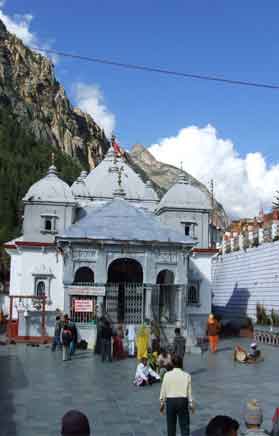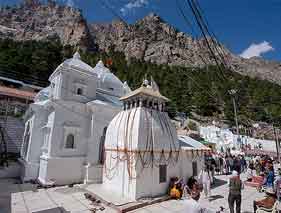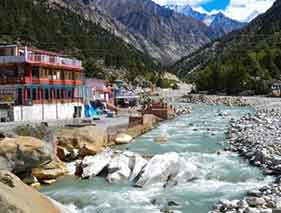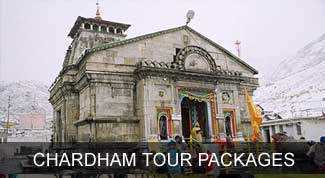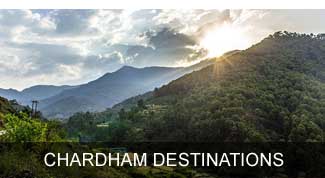This small town is centered around a temple of the goddess Ganga, which was built by the Nepalese General, Amar Singh Thapa in the early 18th century. The temple is closed on Diwali day every year and is reopened in May. During this time, the idol of the goddess is kept at Mukhba village, near Harsil.
Ritual duties are supervised by the Semwal family of pujaris. The aarti ceremony at the Gangotri is especially impressive, as is the temple, a stately affair that sits on the banks of the rushing Ganges. Adventurous pilgrims can make an overnight 18 km trek to Gaumukh, the actual current source of the river Ganges.
Bhagirathi River at Gangotri
For a large number of tourists, Gangotri town serves as the starting point of the Gangotri-Gaumukh-Tapovan and Gangotri-Kedartal trekking routes.
According to Hindu mythology, Goddess Ganga took the form of a river to absolve the sins of King Bhagiratha's predecessors, following his severe penance of several centuries.
Submerged Shivlingam
According to this legend, King Sagar, after slaying the demons on earth decided to stage in Ashwamedha Yajna as a proclamation of his supremacy. The horse which was to be taken on an uninterrupted journey around the earth was to be accompanied by the King's 60,000 sons born to Queen Sumati and one son Asamanja born of the second queen Kesani. Indra, supreme ruler of the gods feared that he might be deprived of his celestial throne if the 'Yagya' (worship with fire) succeeded and then took away the horse and tied it to the ashram of Sage Kapil, who was then in deep meditation. The sons of the King Sagara searched for the horse and finally found it tied near the meditating sage. Sixty thousand angry sons of King Sagara stormed the ashram of sage Kapil. When he opened his eyes, the 60,000 sons had all perished, by the curse of sage Kapil. Bhagiratha, the grandson of King Sagar, is believed to have meditated to please Goddess Ganga enough to cleanse the ashes of his ancestors, and liberate their souls, granting them salvation or Moksha.
Top Tourist Attractions in Gangotri
Gangotri Shrine
The most popular is the Shrine of Gangotri. It is a place of both religious and archaeological importance. The shrine is said to be around three centuries old. On some occasions, soldiers from the Garhwal Rifle perform "Om Jai Jagdish", in the premises of the temple courtyard.
Submerged Shivling
Submerged Shivling, also known as the 'Jalmagna Shivling' is an important site that must not be missed by the tourists. It is one of the most popular tourist attractions in Gangotri where the Lord Shiva held Goddess Ganga in his matted hairs.
Gangotri Glacier
Stretching around 30 kms in length and 2.5 kms in width, Gangotri Glacier is the largest glacier in the Himalayas. It holds a very high importance in the country as it is the source of River Ganga, which is the most pious river in India.
Gangotri National Park
It is a very unique national park mixed with perfect flora and fauna. The landscape is a mixture of green meadows surrounded by the glaciers and coniferous forests. The park has a rich wildlife comprising of Snow Leopard, Black Bear, Brown Bear, Himalayan Tahr, Himalayan Monal, Himalayan Snowcock.
Gangotri Hotels Information
Gangotri is a site for paying homage to the almighty and never-ending fun. One can augment his or her stay by booking the rooms at one of the renowned hotels and resorts in Gangotri. Most of the hotels are situated amid the tranquil environment and lush greenery that offer outstanding facilities and services to the tourists.
Best Time to Visit Gangotri
The ideal time to visit this beautiful hill station is from May to September. The tourists must avoid visiting Gangotri hill station during the monsoon season (June to August), as the region is most prone to floods and landslides.
How to Reach Gangotri?
By Air :The nearest airport to reach Gangotri is Jolly Grant that is around 25 kms from Dehradun and 20 kms from Rishikesh and 278 kms from Gangotri.
By Train :This hill station does not have its own railway station. The closest railhead is Haridwar. The tourists can also board the train from the Haridwar and to spend their holidays in Gangotri.
By Road :A good network of roads connects the Gangotri hill station to the Rishikesh, which is very well connected to Delhi and Dehradun.
